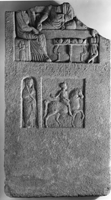 Feasts
were the main way of honouring the dead, first at the time of burial
and afterwards at intervals set by local custom. The feasts were at
first held by the graveside, but in later times took place in a
nearby house of a relative.
Feasts
were the main way of honouring the dead, first at the time of burial
and afterwards at intervals set by local custom. The feasts were at
first held by the graveside, but in later times took place in a
nearby house of a relative.
 Feasts
were the main way of honouring the dead, first at the time of burial
and afterwards at intervals set by local custom. The feasts were at
first held by the graveside, but in later times took place in a
nearby house of a relative.
Feasts
were the main way of honouring the dead, first at the time of burial
and afterwards at intervals set by local custom. The feasts were at
first held by the graveside, but in later times took place in a
nearby house of a relative.
The importance of food is borne out by discoveries of animal bones, eggs, shells and nuts, along with eating and drinking implements in and around tombs. Wine and water jars were set outside the grave to quench the thirst of the dead and mark the final rites at the closing of the grave.